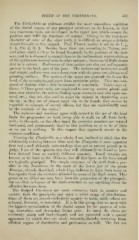Page 441 - My FlipBook
P. 441
TEETH OF THE VEBTEBRATA. 451
The Trk'hechidw or walruses exhibit the most anomalous condition
of the dental organs of any pinniped carnivore so far known, in that
two enormous tusks are developed in the upper jaw, which occupy the
position and fulfil the functions of canines. Owing- to the transitory
character of some of tlie other teeth, it is difficult to assign a definite
dental formula to this animal. Prof. Flower makes it out to be I.
^,
C. \, Pm. M. ^. Besides these there are, according to Tomes, sev-
I,
eral other small teeth to be found frequently in the position of the inci-
sors, and he is disposed to regard them as the rudimentary representatives
of the permanent normal ones in other animals ; there can be little doubt
that he is correct. Rudiments of true molars are also not unfrequently
present in the back part of the jaws. The incisors and molars are small
and simple, and are soon worn down even with the gums into obtuse oval
grinding surfaces. The canines of the upper jaw protrude far below the
level of the symphysis, and grow from persistent pulps. They are com-
posed of dentine with a thin investment of cementum. Tomes says of
them : " These great tusks are employed to tear up marine plants and
turn over obstacles, the walrus feeding upon Crustacea and also upon sea-
weed, etc. ; they are also used to assist the animal in clambering over
the ice ; as they are of almost equal size in the female, they cannot be
regarded as weapons of sexual offence, but they are undoubtedly used
in the combats of the males."
The walruses and sea-lions agree with respect to the use of the hind
limbs for progression on land,' being able to walk on all fours fairly
well ; in the seals, on the other hand, tlie posterior members are rotated
backward, and permanently fixed in this position, so as to be of little
or no use in walking. In this respect they approach nearer to the
cetacean condition.
Viewing the Pinnipedia as a whole, I am inclined to think that the
relationship existing between them and the Finsipedia is more apparent
than real ; and although paloeontology does not at present permit us to
judge, I am of the opinion that they will ultimately be found to have
been derived from an entirgly different ancestry. Fossil remains are
known as far back as the Miocene, but all that have so far been found
are typically pinniped. The simple structure of the teeth finds a par-
allel in the Insectivora in the teeth of the lower jaw of the genus
3Iesgni/i', already described, which Cope believes to ha\^e been more or
less aquatic from the evidence afforded by some of the limb bones. This
genus or an allied one may have been the progenitor of the pinnipeds,
but too little is known of the skull -structure to say anything about the
affinities between them.
The fissiped Carnivora are more extensive, both in number and
variety, than the pinnipeds, and enjoy a wider range of distribution.
Some of them are almost exclusively aquatic in habit, while others are
arboreal, fossorial, or terrestrial. It is in this group that we meet with
the highest specialization of the dental organs for the purpose of seiz-
ing, lacerating, and devouring living prey. In many the claws are
extremely sharp and hookrshaped, and are provided with a special
apparatus by which they are made retractile, thereby rendering them
efficient organs of destruction and prehension as well. The feet are


